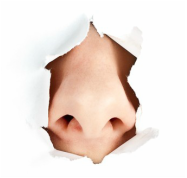 The human nose can distinguish between one trillion smells, according to a publication today in Science. This unfathomable fact is perhaps even more overwhelming considering that previous estimates placed the number of discriminate odorous stimuli around 10,000 odors. In context, most humans can only differentiate 200 colors. While the article provides disruption suggesting how little we know about the nose, it also suggests the important role the sense of smell can play in a marketing context. In the scope of sensory marketing, olfactory techniques are increasingly vital to product promotion and, ultimately, competitive positioning. Consider that 75% of emotions are triggered by smell, and that odors can be recalled with 65% accuracy after a year (versus 50% accuracy for visual stimuli after only three months). The sensory marketing consultancy Brandessence overviews the science behind smell: "When inhaled, these odor molecules travel into the nose and interact with odor receptors. The odor receptors then transmit the information to the olfactory bulb, which is located in the brain’s limbic system. The limbic system also controls memory and emotions, and is connected to the pituitary gland and hypothalamus area that controls the release of hormones that affect our appetite, nervous system, body temperature, stress levels, and concentration. Since the olfactory system is located in the brain, the sense of smell is closely tied to memory, mood, stress, and concentration." Comparing olfaction to the other senses, the marketing agency Eventige refers to a Rockefeller University study that concluded short-term memory is limited to 1% of what we touch (haptics), 2% of what we hear (audition), 5% of what we see (optics), 15% of what we taste (gustation), and 35% of what we smell (olfaction). The significance of scent should be obvious from these facts. The Nose Knows Scent diffusers like this emit concentrated odors into their surroundings. Source: Westin Hotels & Resorts Scent diffusers like this emit concentrated odors into their surroundings. Source: Westin Hotels & Resorts Marketers are increasingly leveraging the sense of smell to attract and retain customers. This is especially applicable in servicescapes where the smell of physical environments can be controlled. Abercrombie & Fitch stores are often associated with their potent perfume "Fierce." The hotel industry also offers an extensive array of examples:
Product scent may be particularly effective at enhancing memory for product information as a function of its ability to enhance a product’s distinctiveness within its surrounding context. Even beyond product positioning and memorability, olfactory marketing can affect temporal decision making. Dunkin Donuts once ran an experimental advertising campaign in South Korea, where municipal buses featured scent diffusers that emitted the smell of coffee whenever a Dunkin jingle was broadcast over a radio. Over 350,000 consumers were engaged through the program, and their subconscious participation provided tangible results for the quick service chain: at stores near bus stops, visits increased by 16% and sales increased by 29%. Heather Balsey, Senior Vice President for America's Brand Management with InterContinental Hotel Group, noted to HotelChatter that particular scents can elicit certain emotional responses or behaviors:
Olfactory marketing is not always subliminal. In fact, it can reach viral appeal through novelty. Burger King is advertising the release of a Whopper-scented cologne in Japanese stores on April 1, 2015; their fragrance "Flame" appeared in the U.S. several years ago, offering brand loyalists or novelty seekers the opportunity to smell like their flame-broiled burgers. In Canada, Pizza Hut showcased a limited-edition perfume "Eau de Pizza Hut," highlighting "top notes of freshly baked, hand-tossed notes." Sales of these products in restricted geographies on limited dates and with typically fixed quantities available for purchase suggest the perfumed ploys are gimmicks aimed at sensationalizing the brands instead of making legitimate attempts at sharing their smells. Regardless, these examples highlight the validity of olfactory marketing within the scope of brand management. To guide businesses with the development of sensory marketing programs, numerous consultancies offer specialized scent design services. ScentAir, Ideair, and SCENT::LINQ are among an expanding presence of marketing perfumers. As scent science advances, these firms and their clients are likely to be increasingly familiar with the smell of success.
Comments are closed.
|

